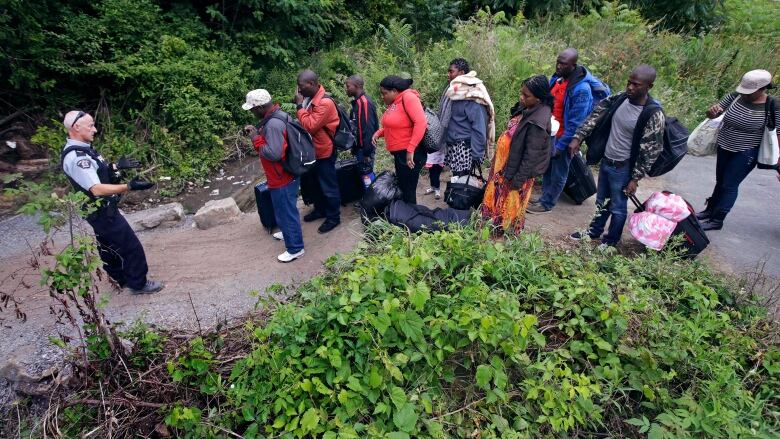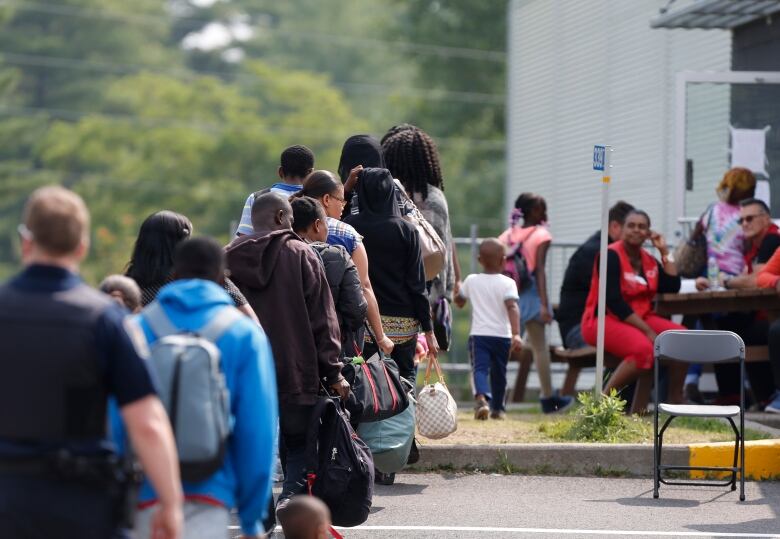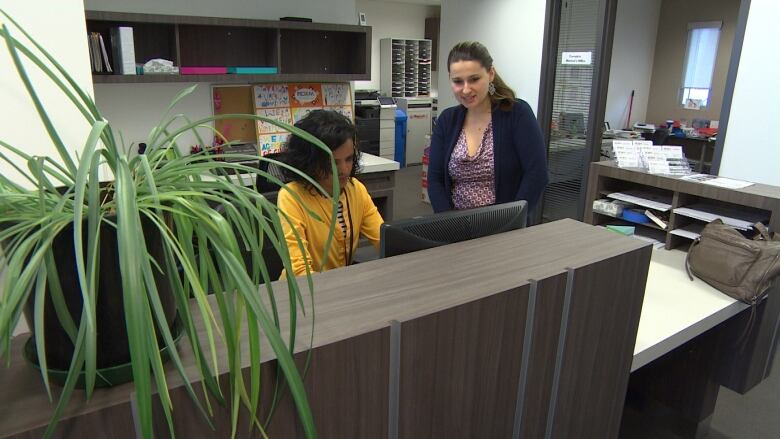Will Donald Trump's latest travel restrictions push more asylum seekers into Canada?
United Nations High Commissioner for Refugees says many claimants always planned to get to Canada

In conversations at coffee shops in border towns across Canada, the talk inevitably turns to the latest political move by an unpredictable president to the south and what that means for the flow of people into this country.
The stream of refugees across the Canada-U.S. border increased after the election of Donald Trump last November, and grew even larger following his first attempt at a controversial travel ban on citizens from certain countries in January. With Trump announcing new restrictions on citizens from North Korea, Chad and Venezuelalast weekend, there was concern about another wave of asylum seekers making the trek north.
But our perception of what is happening at the border is not an accurate representation of what's going on, experts who work in the field say. The number of asylum claims is not unprecedented, they say it's more likeCanada getting back to what was normal earlier this century.
- Trump slaps travel restrictions on North Korea, Venezuela in expanded ban
- Trump's travel ban too restrictive, U.S. appeals court rules
Jean-Nicolas Beuze, theUnited Nations High Commissioner for Refugeesrepresentative in Canada, saidthere has been an increase in asylum claims compared to last year, but in terms of Canadian history, the numberof peopleis still manageable.
"[We need] to paint a more nuanced picture because I think we, including us [at UNHCR]... at the beginning really focused on a decision in the U.S. [leading] to something that happened in Canada," he said.
"But then when we started looking at the profile, it was more complicated than that."
Surge in claimants not unprecedented
From January to July, the flow of people crossing the borderirregularly not at an official port of entry reached 13,211, Immigration, Refugees and Citizenship Canada reports.
More than 800 came into Manitoba, but the vast majority 11,896 crossed on the well-trodden path into Quebec near Plattsburgh, N.Y.

However, the number of claims per year in Canadavaries widely and unexpectedly, said the Social Policy Trends publication from the University of Calgary's School of Public Policy in August, which looked at numbers going back to 2000.
The number of asylum seekers peaked in 2001 at 44,695 claims.
Numbers started to drop significantly in 2012 following the Conservatives' Balanced Refugee Reform Act and Protecting Canada's Immigration System Act, which overhauled the refugee system. In 2012, there were more than 20,000 asylum claims, and the following year, there were only 10,380.
Canada always the plan
There isn't always a clear reason why certain groups come to Canada at certain times, Beuze said, unlike elsewhere in the world.
"It's very clear when a bomb is dropping on a village that within a few hours, you will have people moving away," he said.
"But when the movement is much more organized and on the long-term duration, and when it's a mix of people coming it's much more difficult to predict."
Last winter, many Somalis from Minneapolis crossed into Manitoba after hearing concerning rumours about U.S. Immigration and Customs Enforcementraids; in summer, a surge of Haitians crossed into Quebec, many basing their decision to flee on misleading and false information posted online and in messenger groups.
But among more than 17,240 claims receivedfrom January to June by the Refugee Protection Division of the Immigration and Refugee Board of Canadawhich hears claims for refugee protection made by people already in Canadaonly 467 were from Somalia and 897 were from Haiti.
The vast majority were from Turkey(1,061)and Nigeria(1,466) and neither country was underthe travel ban.
The federal government is investigatingthe misuse of U.S. travel documents, whether money has changed hands and the possibility that peoplehave engaged in a deliberate misinformation campaign as possible contributing factors for theincrease in asylum seekers crossing the border illegally into Canada.

"It's very much an individual decision" at the end of the day, Beuze said.
Many of the asylum seekers he spokewith over the summer had always planned to come to Canadaand were just travelling through the States an increasingly common story that he didn't initially expect.
"They were not staying in the U.S. and they were not affected by the new administration," he said."They were just [using the] benefit of an American visa but, like it was the case before the new administration, [they] always had in mind to come to Canada."
'Greater amount of focus'
While this year's numbers may not be the highest in the last 17 years, for many Canadians, it's the first time they've had to consider why someone would cross a border, said Dorota Blumczynska, executive director of the Immigrant and Refugee Community Organization of Manitoba.
"This is not such an extraordinary time," she said, but "there is a greater amount of focus on this."
In an August poll, 56 per cent of people said they don't believe it's acceptable for migrants bypassing normal immigration procedures to be treated as a priority, and 39 per cent said they feel the large influx of migrants will make Quebec less safe. An earlier poll said one in four Canadians wanted the Liberal government to impose its own Trump-style travel ban.
Anti-immigration rallies have also drawn crowds and counter-protests across the country.
- Thousands promise to come out and protest against Canadian Nationalist Party rally
- Far-right protest in Quebec City worries anti-racism advocates
Blumczynska said it's important to make it clear that people seeking asylum aren't just fleeingTrump's policies and to break other misconceptions around refugees.
"When there is a great amount of fear in our hearts, we are less compassionate," she said.
"The only way to respond in this situation is to deal with the fear to make space for a compassionate response, to ensure that we continue as Canadians to value the human beings that are taking great risks, and many sacrifices, and who are, in fact, fleeing persecution and seeking our protection and our welcome."

Trump's new restrictions, which primarily target people from North Korea and Chad, are slated to take effect on Oct. 18. They also target some Venezuelan officials, which the country's foreign ministry denounced as a form of "political and psychological terrorism."
'Back to the normal?'
Winnipeg immigration lawyer Alastair Clarke has three Venezuelan clients and has been contacted by others who are still in the South American country. He said they aren't motivated by the travel restrictions but instead by the political and economic crisis in the country, where basic goods are becoming scarceand unaffordable, and there is an acute shortage of medicine.
"I have one woman who did not want to leave her home for many weeks," he said. "She didn't even want to take the garbage to the sidewalk because she was afraid she would be attacked on the streets."
The people he has spoken with in Venezuela are trying to figure out how to come to Canada because they see it "as a place of safety and certainty,"and they never intended to livein the United States, he said. But he doesn't expect the number to be too large because the journey is long and difficult.
So far that seems true, with 443 claims from people from Venezuela received by the Refugee Protection Division of the Immigration and Refugee Board of Canada from January until June 2.5 per cent of all claims received.
It's important to watch what's happening to the south, butthat can't be the only focus of refugee policy, Beuze said.
Canada needs to make sure it's prepared if, in fact, the country is going back to the normal asylum claim rates of 15 years ago, when there were 30,000 to 40,000 claims annually no matter who is in the White House.
"Are we simply going back to the normal prior to this reform? It's very difficult," he said.
"We are too close to the event to really analyze the trend."
With files from CBC's Radio Noon












_(720p).jpg)


 OFFICIAL HD MUSIC VIDEO.jpg)
.jpg)



























































































